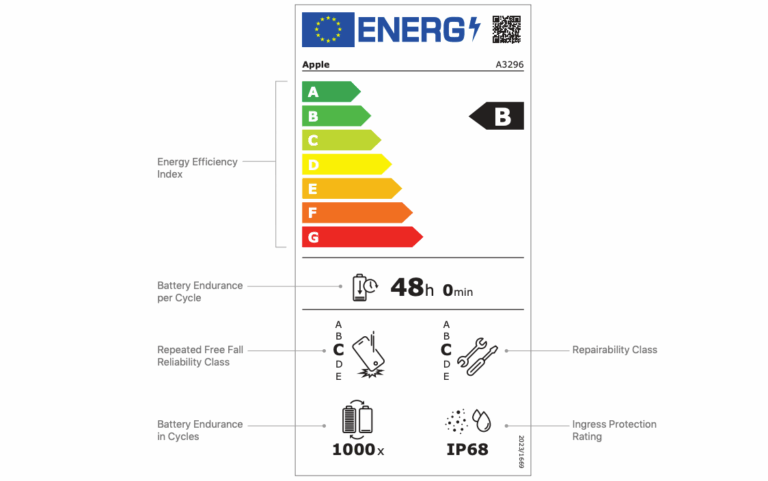
Apple has introduced energy-efficiency labels on its iPhone and iPad product webpages in EU countries and will include them with new devices sold in the region. This follows the implementation of Europe’s Ecodesign regulations on Friday, which mandate energy labeling for smartphones and tablets.
The new labelling requirements have prompted Apple to disclose notable details about its device lineup.
What did Apple grade its iPhones and iPads?
The label must display key metrics on a device’s energy efficiency, battery endurance, ingress protection against water and dust, and repairability. The Energy Efficiency Index is graded from A to G, with A representing the highest level of efficiency.
According to Apple, all iPhones currently sold in the EU have a B rating on this scale. However, Apple states that its internal testing — which involved running a standard workload on the device until the battery was fully depleted and comparing that runtime to the battery’s capacity — actually qualified the devices for an A grade.
Apple said it intentionally downgraded the rating “to minimize the probability that a third-party tester interpreting the regulation differently would achieve a lower grade,” as explained in its 44-page supporting document. It also downgraded the devices in the Repeated Free Fall Reliability Class — which indicates the number of drops they can withstand before sustaining functional damage — for the same reason.
Most iPads received a poor G rating, while the iPad mini scored slightly better with an E rating.
Apple shared details on how it conducted testing for each of the metrics required by the EU energy label, saying that parts of the regulations contain language that is “ambiguous, conflicting, or open to interpretation,” which can lead to inconsistent results. “While we expect to gain more clarity through the adoption of harmonized standards, in the interim, we chose to provide an explanation of our methodology,” the company wrote.
The EU-mandated label can be viewed on the main product pages and purchase pages for all currently sold iPhone and iPad models. More detailed information can be found on the European Commission’s online database.
Apple’s ratings of iPhones’ and iPads’ fall reliability, battery life, maximum immersion depth
Fall reliability
For fall reliability, the iPhone was rated C, while most iPads were rated E, suggesting they’re more fragile. iPhones are rated 4 on the Mohs hardness scale, meaning they resist scratches from materials with a hardness below that level, such as copper, but remain vulnerable to harder substances like steel or glass.
Battery life
The new EU-mandated documentation also includes specific battery life figures, whereas Apple’s marketing typically provides only general estimates. The iPhone 16 and iPhone 16 Pro Max, have the longest battery life, lasting 48 hours, while the iPhone 15 has the shortest at 34 hours. The documents also state how many charging cycles it takes for a battery’s capacity to drop to 80% or 1000 cycles for the iPhone 16.
Maximum immersion depth
The documentation specifies the maximum immersion depth at which each device can survive. For all iPhone 16 variants, as well as the iPhone 15 and iPhone 15 Plus, this depth is six metres. It also confirms that iPhones will receive at least five years of software updates.
Apple has had to bend to the EU’s wishes in the past
The EU’s regulatory push has often been a challenge for Apple. Since early 2024, it has allowed EU users to delete pre-installed apps, made changes to the App Store, and made Apple Intelligence compliant with the Digital Markets Act, all to avoid hefty fines from the European Commission. It also stopped selling iPhones with the Lightning Port in the region, as all devices were required to be USB-C compatible in December 2024.
However, Apple has not accepted all demands without resistance. Earlier this month, Apple appealed against the EU’s requirements to allow third-party hardware access to its platforms. It also has yet to make changes that would enable developers to freely steer users toward external purchasing options outside the App Store, even after being fined €500 million.
Want to know what Apple revealed at WWDC this year? Check out TechRepublic’s full breakdown of the latest iOS, macOS, and Apple Intelligence announcements.

